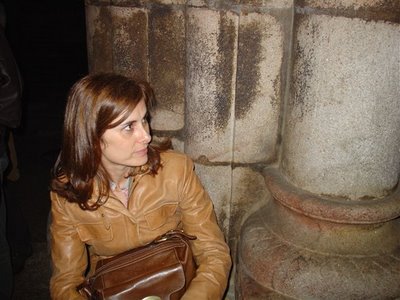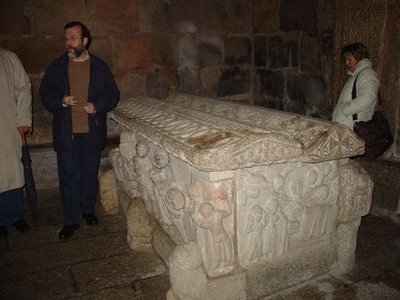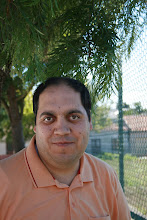quinta-feira, dezembro 21, 2006
A Man for All Seasons by Hugo Alves
While reading the book A Man for All Seasons, I realized that the events related in the book took place a few centuries ago, but that some things continue the same in our day. For example, Sir Robert More was a great model of all goodness that we find in a person, but he was surrounded by evil and wrong doing.
A few experiences in particular caught my attention. The first was when Roper asked More to marry his daughter and More refused, claiming differences in religion. Second, More’s servant Steward was receiving bribes from More’s “friends,” in exchange for some private information. A third instance and perhaps the most important was when More could save himself from death by just pronouncing some words.
As I mentioned in the previous paragraph, one of the experiences that I like the most in this book took place when Roper, a friend of Sir Thomas More, asks to marry his daughter. As we found from reading the passage, Roper is a Lutheran, and of course, More is a strong Catholic. The conflict starts right here. Sir Thomas More totally rejects the idea of seeing his daughter marrying outside the Catholic Church. Now, this sounds really familiar to me. As a member of The Church of Jesus Christ of Latter-day Saints, and mainly after I came to Idaho and now Utah, I have been really exposed to this concept or idea. Many Latter-day Saint parents do not agree and many times do not support, the idea of having their kids marrying someone outside their church. Understanding that this is a very sensitive concept, it is hard for me to take a position and say that I agree with More or the LDS parents or not. I do understand that life and marriage are already too complicated, so if religion will not unite the couple, things tend to be even harder. With this point of view, I believe and strongly agree that marriage should always stay in the bonds of the same religion. What I can’t accept however, is parents forbidding their kids to marry the one they love. Once a son or daughter decides whom they will marry, the parents should always support them, especially if the only question is religion.
But the book is not only about marriage or religion. Bribes and corruption also occurred in the book. The best passage that describes this is when More’s servant, Steward received some coins in exchange for some information regarding his master, information that in reality was only half true. Steward only tells what the person wants to hear. Steward says, “I could have told him any number of things about Sir Thomas…But that’s what he wanted to know”(p. 42). Later in the book, when Sir Thomas More is having financial struggles, his servant ends up leaving to go to work in another house. Personally, I was really surprised to see that happen. I had the idea that the British servants were really loyal to their masters. But once again, most people in this story reflect only negative values.
Fortunately, Sir Thomas More was a great example of positive virtues, such us righteousness, loyalty and honesty. But most of all More was a sincere man. In a conversation with King, Henry VIII, More is recognized by the king for his sincerity (p. 55). And how sincere was this man? When being on trial for treason, More was given many opportunities to agree with the king’s new changes in religion, but he never did. While in jail, the persecutors sent More’s family to change his mind, but he never did. It come to a point that the persecutors told him just to say that he agreed with the king, even if in his heart and mind he didn’t. But he never did, and he was decapitated.
I never heard of Sir Thomas More experiences until I read this book. I’m well pleased with the example and values that I learned from his life. His life teaches us that we should always stand for what we believe. We can for certain learn much from a person like Sir Thomas More. Sir Thomas More shows us how honesty is important in a person lives. More teach us that dignity is far more important than money and social position. In other words, society needs more “Mores.”
Should Tax Money Be Used in Embryonic Stem Cell Research? by Hugo Alves
Adult stem cell research has been around since the 1960s. The method used by this technique is improving in a way that success is being achieved. So the government never faced much opposition in funding adult stem cell research. The same does not apply to embryonic stem cell research. With a different process of extracting cells, the government is getting much opposition from politicians, scientists and the public in general to approve a bill which would allow the government to fund embryonic stem cell research. Since these researches, in general, can only survive with governmental funds, the crucial question is should the government fund embryonic stem cell research?
Even if the government is the only way to finance embryonic stem cell research, I don’t think the government should do it. Why? To better answer that question, it is important to focus in a variety of aspects that are related to this subject. I’m against embryonic stem cell research because it is a very complex process that involves ethics and effectiveness per money spent and avoids regulatory laws.
Ethics.
Concern is rising among the general population, since scientists started to use embryos in their experiments. For many such a study is purely unethical. Ethics are and will always be, the point more discussed in the embryonic stem cell research. For many, the process that involves extracting the cells from the embryo of a fertilized egg and using them is unethical. This controversy goes back to the initial method used by the scientists to extract the cells from the embryo. In the beginning, for scientists to extract and separate the cells, they had to destroy the embryo. In a Heritage Foundation Lecture, Kelly Hollowell, a J.D., Ph.D. spoke on this subject, raising the question, “Are human embryos people or property when they are destroyed for the purpose of obtaining their stem cells?” The answer, according to Kelly Hollowell, is clearly, “Life does begin at conception” (lecture: 888).
However some scientists are now refuting this argument. It seems that scientists are now able to extract the cells without killing the embryo. According to the Medical News Today, “Scientists at Advance Cell Technology of Worcester, Massachusetts, have succeeded in deriving stem cells from mouse embryos without killing them” (Christian Nordqvist).
Even if new techniques would allow the scientist to extract the cells without killing the embryo, people, in general, would still be very defensive about such methods. Anything that involves human life, even in the early stages, will always raise concerns and doubts in the minds of many people.
If killing or tampering with human life isn’t already reason enough to stop with this research, I can add another question that has brought more concern to the public in general. Are the scientists looking for embryonic stem cells to cure some diseases, as they say, or are the scientists looking for ways to improve the cloning process? Some people have already started to compare this research to cloning, not that they are the same, but because they involve the same principles. At the same time, many people fear that embryonic stem cell research can open new doors to the process of cloning.
Senator Tom Coburn (R-OK), M.D., a practicing physician, in a press release commented on the President’s decision not to fund embryonic stem cell research, saying, "What President Bush's veto will stop, however, is a step toward a brave new world of human experimentation and, eventually, cloning.” In this same article, Senator Coburn states that embryonic stem cells alone can never be used to cure any disease. This statement completely contradicts the position of those who defend the embryonic stem cell research as a way to solve some health problems.
Effectiveness per money spent.
Without question, ethical concerns will always be a part of this discussion. But what some scientists are also discussing is the effectiveness of the embryonic stem cell method, especially when the possible costs of such methods are extremely high. To better understand the process of using embryonic stem cells, Kelly Hollowell, in the lecture, What Taxpayers Should Know, gave an example of the possible situation:
Specifically, the process requires women's eggs. To treat, for example, only the 17 million diabetes patients in the United States would require a minimum of 850 million to 1.7 billion human eggs. You can literally envision women becoming egg factories. Collecting 10 eggs per donor will require a minimum of 85 million to 170 million women, and the total cost would be astronomical, at $ 100,000-$ 200,000 for 50 to 100 human eggs per each patient.
Without any refutation from its opponents, this report is a very powerful tool against embryonic stem cell research. Considering these numbers, any attempt to take this research forward becomes very risky because high costs, and more importantly, women’s health are also at risk. As doctor Hollowell mentioned in her report, women could become a “machine of fertilizing eggs.” If we now consider that scientists have failed to come even close to a positive result in previous experiments, and with such high costs to put in practice such ideas, the government and the public in general need to think twice before any money can be used in such projects. The government should always be responsible to use tax money in projects and activities, first, that are for the benefit of the majority of the population, and, second, that the objectives and results of such a project are clear and successful.
With this, I'm not saying that money shouldn't be used to save or cure health problems or that life has a price. What I'm trying to say is that, investing in projects that have no future or that the future doesn't bring any hope for the people who need the help, needs to be pondered. In almost all the cases, the people that want the embryonic stem cell research to go on don't have any support in their defense. The only thing they keep repeating is that many children are dying or suffering with diseases, and embryonic stem cell research could be the answer for their problems.
In our day, there are many new diseases, mainly related to cancer, for which doctors are having a hard time finding a cure. Because such diseases are related to the destruction of cells, doctors are looking into different ways to replace the dead cells with new ones. This is a possibility, but can never be used as an argument to convince the government to invest into the embryonic stem cell research.
With this type of argument, defenders of the embryonic stem cell research are using people in a very insensitive way. How? By creating false hope for the many that today suffer from diseases that doctors can’t cure. A good example, of the use of this argument is Senator Hatch, a strong defender of embryonic stem cell research and one of the most active members in the senate, who wants a bill passed which allows the government to invest in embryonic stem cell research. Senator Hatch, in the speeches that I read, uses the argument that many people are suffering, especially little children, from diseases that can be cured if scientists have the resources to continue their investigation on embryonic stem cells. Often I found Senator Hatch reading letters that he received from patients. In a speech given to the Senate, released by the Office of Utah Senator Orrin G. Hatch, in 18 July 2006, I can quote from Senator Hatch, exactly:
1. I can think of nothing that will provide as much meaningful therapy for children and children's problems than the promise offered by stem cell research.
2. One reason why I support stem cell research so strongly is because I have heard from so many of my fellow citizens of Utah and fellow Americans about how important this issue is to them and their families.
3. One of the reasons why so many are so interested in this debate is that literally everyone either has, or knows, a loved one who has one of the diseases or conditions that may one day benefit from stem cell research.
4. That is the reason why Nancy Reagan wrote me the . . . about stem cell research.
Referring to this exact problem, Senator Coburn, an opponent to the embryonic stem cell research, expresses exactly the same concern. As mentioned previously, Senator Coburn and other doctors and scientists that are against embryonic research, believe that no cure can be achieved with this specific research and that creating false hopes is not the way to support such research. At the same time, they believe that the government should only invest in clear, strong and effective projects, and not in the foolish dreams and hopes that some scientists have.
The truth is that the past has proven that Senator Coburn is right. After some years of experimenting with embryo cells, the results are all negative, and the progress is slow or none. The scientists have failed in all attempts to cure any disease using embryo cells. To the Committee on Senate Appropriations Subcommittee on Labor, Health and Human Services, and Education, Doctor George Q. Daley, an Associate professor, Biological Chemistry and Molecular Pharmacology at Harvard Medical School and a strong defender of embryonic stem cell research, admitted, “It is true that no one has to date been treated with cellular therapies based on human embryonic stem cells” (12 July 2005, 3). By the way, saying that the government needs to invest more money so the research can be successful, in my view is not a valid argument. Therefore, the government needs to invest more in adult stem cell research or in other researches that are less problematic and more effective, because positive signs and good results are being achieved.
Scientists, I believe, are always looking for ways to cure and improve human life. The same can not be said about politicians and business men. For the government to fund such research, like many other researches, some people will benefit financially. Many times I wonder about the true reason behind some of these projects. After reading and thinking about this particular subject, I feel that some people are involved in this discussion for the purpose of personal financial improvement and not the well being of mankind. What else would move politicians, some scientists and many business men to this particular subject? If we go back to the original concern of this point, the high cost for ineffective research, I can see why many people would prefer working with embryonic stem cell research instead of keeping improving the adult stem cell or any other method. Money always plays an important factor in our society, some times even more than human lives.
With the hope of finding a cure for many health problems, in the speech of the ones that defend embryonic stem cell research, may have expectations of making some profit in the back of their minds. Maybe these people don't even care about the legal aspects of the problem.
Regulatory Laws.
The U.S. Constitution doesn’t have any laws that regulate the methods and procedures that embryonic stem cell research uses. The problem isn’t unique. Every time that the government faces a new event, it’s normal to expect that no regulation exist. It happened the same with the internet, for example. It is impossible to create laws for things that don’t exist! On the other hand, what the United States Congress received was the concept that life begins at conception. In 1981, during the hearings on the Human Life Bill, organized by the Senate Judiciary Committee's Separation of Powers Subcommittee, some internationally renowned scientists testified that life begins at conception, leaving no room for scientists to play with the embryo cells. If the government agrees that life begins at conception, it doesn't make much sense that they would approve and pay for some scientists to destroy, modify or even experiment with a human being.
There is still much to be discussed in relation to the legality of this and other methods that use fertilized eggs for their studies. A few years ago, when scientists were making great progress with cloning, they found in the public opinion their greatest opposition.
A good number of our population is very concerned with the use of human lives for experiments. So what will happen with the embryonic stem cell research legally? No one knows. Today the government can spend millions on this research and tomorrow a law could be created that prohibits its application. This doesn’t make any sense, but it could easily happen. So what is the solution? In my point of view, the government needs to identify the values and opinions of the population and then regulate the embryonic stem cell research. In other words, it is urgent for the government to first regulate this matter and only then think about financing it.
How hard can it be for the Congress to pass a number of bills that regulate and protect such techniques? If the funding by the government for such methods is raising so much conflict, I can't picture in my mind the Congress approving laws that allows the use of such methods, and if we don't allow the use of such methods, why than invest in them.
I understand that a cure for some of the more recent diseases that affect us is very important, but what I’m discussing here is the method of achieving it. The concept that, to save a life we can break all the rules, doesn’t appeal to me, specially, when there are more options that can be used. I refuse to accept the embryonic stem cell research, but at the same time, I believe and agree with the use of adult stem cells or even others methods that are not as questionable as the embryonic stem cell research.
Works Cited
Coburn, Tom. “Sen. Coburn Applauds Bush’s Pledge to Veto; Says Stem Cell Bill Promotes False Hope, False Choices.” HT Media Ltd 18 July 2006. Lexis Nexis. LDSBC Lib., Salt Lake City. 10 October 2006
http://web.lexisnexis.com.erl.lib.byu.edu/universe/document?.
Daley, George Q. “Congressional Testimony.” Congressional Quarterly, Inc 12 July 2005. Lexis-Nexis. LDSBC Lib., Salt Lake City. 10 October 2006
http://web.lexisnexis.com.erl.lib.byu.edu/universe/document?.
Hatch, Orrin G. “Hatch: Senate Backs Expanding Stem Cell Research.” States News
Service 18 July 2006. Lexis-Nexis. LDSBC Lib., Salt Lake City. 12 October 2006 http://web.lexisnexis.com.erl.lib.byu.edu/universe/document?.
Hollowell, Kelly. “Federal Stem Cell Research: What Taxpayers Should Know?” The
Heritage Foundation. 24 June 2005. Lexis-Nexis. LDSBC Lib., Salt Lake City. 10 October 2006
http://web.lexisnexis.com.erl.lib.byu.edu/universe/document?.
Nordqvist, Christian, “Deriving Stem Cells without Killing Embryo.” Medical News Today.
23 August 2006.
http://www.medicalnewstoday.com/healthnews.php?newsid=50329
04 December 2006.
Taft, Kingsley L. “Stem Cells: Their Promises, Their Problems.” Gale Group, Inc.
9 March 2005. Lexis-Nexis. LDSBC Lib., Salt Lake City. 17 October 2006
http://web.lexisnexis.com.erl.lib.byu.edu/universe/document?.
Marshmallow Mateys by Hugo Alves
The product chose for this paper was: Cereal Marshmallow Mateys, owned by Malt-O-Meal Company. Malt-O-Meal Company is private held. The Brooks and Fort families own the company.
The company was created in Minneapolis, Minnesota in 1919 and the headquarters prevail in there until the present day. The company employees 55200 as of January, 2005.
John S. Campbell developed the first hot cereal in Minneapolis, Minnesota. They supply more than 22 different ready-to-eat cereals, including brands like Honey Graham Squares, Toasted Cinnamon Twists, Berry Colossal Crunch, Honey Buzzers, Frosted Flakes and Puffed Rice and Puffed Wheat cereals. With its acquisition of the bagged cereal business from Quaker Foods & Beverages, Malt-O-Meal is poised to become an even bigger player in the value segment of the ready-to-eat cereal market. The fourth largest.
How to produce?
The main ingredients are; whole grain, oat flour, marshmallows, sugar, corn syrup, wheat starch and salt. To acquire their goods, Malt-O-Meal hired companies to find in the market, the best places to buy these goods. Often times, the goods are acquired directly to the farmers.
To package, Malt-O-Meal decided to install a robotic case packing machines in the new facility in Utah. With these machines they are able to work 24/7. Package volumes range from 6-oz up to 46-oz, depending on product variety and package type. These robots are easy to adjust. For the distribution of cereal, one example mentioned that Malt-o-Meal contracted a firm (Minneapolis-based Air Plus LTD.) to deliver the cereal to more then 1000 Wal-Mart stores. Wal-mart is a great market for Malt-o-Meal. As are many other grocery stores that will sell their product.
One of the features of the new plant in Utah that innovates the way Malt-O-Meal produces is its state-of-the-art gun puffing system. Gun puffing is a process in which cereal grains or extruded cereal dough shapes are treated with high heat and steam pressure. The pressure is then released and the objects puff up or expand. They are also cooked at the same time by the heat. Water and grain or extruded shapes are added to the 'gun' and then heated and rotated to produce steam until the pressure reaches 200psi. The 'gun' is then aimed at a collection bin and the lid released by a firing mechanism: As soon as this happens, the drop in pressure will cause the steam within the grains or shapes to expand rapidly and thus the grain with it. The expanded shape is fired into the collection bin. New innovations to this process such as grain preheating in a fluidized bed reactor have meant over 90% efficiency to the process; older systems typically gave a 30% wastage or rejection rate. The new system also has a multiple rotating gun to increase throughput and capacity; output can be up to 1,000kg per hour. The cereal shapes are then graded for quality and passed onto the syrup coating process.
The plant in Utah produces 125.000 bags a day (They have two more plants and a total of 14 lines). In this factory, typical casing speeds are approximately 140 bags or bags-in-boxes per minute. Just for curiosity, each line can run six to eight package sizes and usually can be changed over in less than 15 minutes. Their revenue for 2001 was of $365 million.
Malt-O-Meal, like many others companies that are involved in food processing, is very regulated. To control the safety of all the foods the, government creates laws to assure that no harm will happen to the people that consume it. They have regulations to process the food, package and distribute food. One of the latest problems that Malt-O-Meal had was with salmonella. They have law suits against them because of some contaminations. For example, the Food and Drug Administration (FDA) and the Centers for Disease Control and Prevention (CDC) of the U.S. Department of Health and Human Services (HHS) and the Food Safety and Inspection Service of the U.S. Department of Agriculture (USDA), had just release the 2005 edition of the Food Code. This edition of the Food Code provides practical, science-based guidance and manageable, enforceable provisions for mitigating risk factors known to cause food borne illness. The Code is a reference document for regulatory agencies that ensure food safety in food service establishments, retail food stores, and other food establishments.
There are permits issued by the Minnesota Pollution Control Agency. These permits identify the units at each facility that generate air pollutants and, where applicable, the limits on those emissions. Each permit is listed as Federal or State. A facility with a federal permit has a higher allowable emission than a state permit and can be subject to different requirements. The amount of pollution being released into the air is causing alarm to the people of the surrounding areas. The smell is not pleasant, but the worst effect is the problem that the smoke can cause to the health of the people. With this in mind, the company is very strongly involved in reducing the air pollution.
For whom to produce?
The Children in the United States are the main consumers of Malt-O-Meal cereals. Twenty million families bought Malt-O-Meal cereal last year. The families acquire these good mainly through wholesalers (Wal-Mart, Cost Co, Albertson’s…)
The whole cereal market is valued at $8 Billion. This industry is very competitive. Some of the competitors are: Kellogg’s, General Mills and Post.
Seeing this Market as an Oligopoly, there are many barriers to entry. Some of them are: distribution control, mergers and acquisitions, advertising and warranties and patents. Distribution control happen when a company persuade a retail outlet's not to peddle anyone else; mergers and acquisition, just what the words means, two companies can merge and become so big that it is impossible to compete or the big company will simple buy the new company; advertising is a big one; and warranties and patents, is the right to keep the type of production of being copy.
Malt-O-meal can be considered a normal product. Because, even if the income increases, everyone will still consume the cereal and probably even more. If not, with an increase in the income, people could change for any other kind of breakfast, or name brand cereal, making Malt-O-Meal an inferior good. It depends on an individuals taste for cereal.
The one complimentary good for this product is milk. With the increase of price in the cereal and consequent reduction in the demand, will be a decrease in the demand of milk. As for the substitute goods, there are many different breakfast options. If all the consumers of cold cereal changed their habits, then the demand for pancakes, donuts, fruits and all the hot cereal will increase.
There won’t be a big change in the demand of this product with a change in the economy. This is due to malt-O-meal already being one of the cheapest products in the breakfast market. Consumers can live without this but, in a time of crises, it not likely to be the first thing we give up. This product is already part of the diet of many people.
UTAH BANKRUPTCY BY HUGO ALVES
Espero que desfrutem e se quiserem entar em contacto com o autor, terei o maior prazer, em facultar o email dele.
Since the 1960s, the state of Utah has consistently ranked in the top quarter of bankruptcy rates in the USA. By the 1980s, Utah was already in the top 10 states, reaching the number 5 “worst” state before 1990. In 2002 and 2003, Utah emerged in the top position with the highest household bankruptcy rates. For instance in the end of March, 2004, one in every 36.5 Utah household filed for bankruptcy, becoming again the highest percentage for householder in the nation (Dave Anderton 2004, Online). In general, there are many theories on the causes of bankruptcy throughout the USA: “Job loss, divorce, overspending, excessive debt, poor financial management skills, disability, substance abuse, insufficient income, lack of health insurance and high housing costs” (“Bankruptcy rate caused by credit problems” 2005, Online). But what in reality is causing Utah to have the number one bankruptcy rate? According to the “Utah Foundation Press Release” (December 15, 2004), the economic factors that may play a strong role in Utah's bankruptcy problem include “. . . larger than average families and homes, low wages, high home prices, and high charitable commitments . . .” (Online). Easy credit and the “local legal culture” also make Utah very susceptible to bankruptcies (Farnsworth, 2004, online).
To better understand the bankruptcy problem in Utah, there are a few statistics that are important to mention. From an article by Dr. Jean M. Loan and Dr. Barbara R. Rowe (2002) I have gathered the following statistics:
1. Size of families in Utah are on average 3.57 persons compared with 3.14 for the U. S. as a whole, becoming the largest families in the nation (qtd. in U. S. Census Bureau, online).
2. “The State has the youngest population with a median age of 27.1.”
3. Per capita income in Utah, for the year of 1995 was $18,054. This is 76.6% of the national average, “. . . placing it 45th of the 50 states.”
4. Utah women wages are 62% of males wages, when compared to the 75% of the rest of the USA to cause it to become “. . . the largest gender gap in the nation” (qtd. in Utah Dept of Employment Security 2001, online).
5. “The cost of raising children to age 18 continues to climb to almost a quarter of a million dollars (qtd in Lino 2001, online). With an average of one half more persons per household, the high cost of raising children is a significant financial factor for Utah families.”
6. Adding to all these numbers, Utah has the largest home sizes in the country as well as the most number of cars per family (qtd. in Loomis 2001, online). “More than one-fourth of Utah homes contain eight or more rooms” (qtd. in "Utah leads nation" 2001, online).
In conclusion, economists speculate that large family size, with all the costs associated with it, and low per capita income contribute to Utah’s high bankruptcy rate (Overbeck 2001, online).
sábado, dezembro 02, 2006
Fotos da Visita de Estudo da VI Semana de Estudos Medievais

A primeira paragem, Cete... ou seria cacete?
O "Trio de Ataque". Da "sinistra" para a direita, Professor Luís Miguel Duarte, Professora Lúcia Rosas e o Dr. Luís Carlos Amaral, sendo os dois últimos os mestres de serviço.
Duelo de Titãs, a Professora Iria Gonçalves em prova oral perante o Dr. Vaz.
Ainda em Cete, o Inspector Mattoso, procura indícios que ajudem a solucionar o "Caso Desembargo". Um jornaleiro local apontou o Mosteiro de Paços de Sousa antes de ser atingido por uma seta envenenada... E a malta lá seguiu a indicação do mártir.
A Professora Paula Pinto no descanso da guerreira que antecede a grande batalha, teve ainda tempo para informar que andava um trio suspeito junto à fonte... fomos ver.
Cá estão... não enganam ninguém... são mesmos manfios medievos. O "padrinho" usa chapéu.
Ainda em Paços de Sousa, junto ao túmulo de Egas Moniz, o homem que ameaçou enforcar-se caso não entrasse no mestrado em Medieval. Com aquela média devia estar à espera de um milagre, e os santos que estavam em greve...
Como sempre, quem quer ver o Blogger, é só procurar por uma mesa onde haja comida.
A monumentalidade de Pombeiro ficou para depois do almoço.
Houve suspeitas em relação à prova oral e foi necessário espiar (to bug) a Professora Iria, enviamos uma Joanhinha (Bug) ...
E para que ninguém fique com a ideia de que a visita foi unicamente ver ruínas e candidatas a tal, cá fica uma imagem que representa a muita beleza natural que foi possível desfrutar ao longo de todo o dia.
Para acabar, já Jesus Cristo dizia, "dai a Flávio o que é de Flávio"...
Um mais que merecido agradecimento ao Flávio, que uma vez mais fez uma cobertura pictórica espectacular.
N.B. Avançamos ainda a informação de que no sítio da VI Semana de Estudos Medievais, existem fotos dos outros dias (27 e 29), bem como um inquérito que visa aferir uma primeira avaliação, ainda a quente, do evento. Não deixem de ver e de dar a vossa opinião.
sexta-feira, novembro 10, 2006
Blog Oriente Antigo
Podem ainda encontrar uma lista de links para páginas "obrigatórias" sobre o tema.
Está ainda disponível a possibilidade dos interessados de subscreverem as actualizações de posts novos na sua conta de correio.
Não deixem de ver. Mais uma vez, se avisa que no título está um link directo para o blog.
terça-feira, novembro 07, 2006
VI Semana de Estudos Medievais
Resta-me remeter todos os eventuais interessados para o link do evento, que conta este ano com uma página muito boa. Ver para crer.
terça-feira, outubro 24, 2006
PERCURSOS DE UM HISTORIADOR
Colóquio de Homenagem ao
PROFESSOR DOUTOR FRANCISCO RIBEIRO DA SILVA
Dia 8 de Novembro de 2006
Mês de História - 2006
MÊS DE HISTÓRIA - 2006
Em cerca de 30 dias que decorrem de Outubro a Novembro, o Departamento de História da FLUP apresenta, como habitualmente, um conjunto de eventos para os quais chamamos a atenção dos interessados.
Desde 2 de Outubro até 15 de Novembro decorre na Biblioteca Pública Municipal do Porto a exposição As Pequenas Coisas: Recordações de Mulheres 1910-1950, organizada em parceria pelo Instituto de História Contemporânea (Org. Maria José Moutinho Santos) e CMP / Pelouro da Cultura / BPMP.
18 de Outubro – RECEPÇÃO AOS ALUNOS DO 1º ANO. 10h; 11 h- Visitas à Biblioteca da FLUP; 15h30 – Colóquio “História e Mercado de Trabalho”; 17h30 – Confraternização.
Em 19, 20 e 21 de Outubro - II SEMINÁRIO INTERNACIONAL sobre O SAL PORTUGUÊS. Organização: Inês Amorim (IHM-UP, FL-UP), Filomena Martins (DA-UA), Ana Margarida dos Santos (UA). Em Porto/Aveiro/ Figueira da Foz/Leiria.
26-28 de Outubro - I CONGRESSO INTERNACIONAL DE HISTÓRIA ORAL. Organização de Luís Alberto Marques Alves (Instituto de História Contemporânea / Mestrado em História e Educação), na Biblioteca Almeida Garrett.
Em 3 e 4 de Novembro - SALAZARISMO, TARRAFAL E GUERRA DE ESPANHA: HISTÓRIA E MEMÓRIA 70 ANOS DEPOIS. Org. de Manuel Loff/Instituto de História Contemporânea (FLUP e UNL)
Em 8 e 9 de Novembro - Colóquio "Percursos de um Historiador - Francisco Ribeiro da Silva".
De 12 de Outubro até 30 de Novembro (às quintas feiras, 18h30), no Museu do Vinho do Porto (rua de Monchique), ciclo de conferências 250 ANOS DEPOIS, a propósito das comemorações da criação da Região Demarcada do Douro (org. GEHVID).
21 de Novembro - Portugal ante o Bloqueio Continental de Napoleão. Organização de Jorge Martins Ribeiro / Instituto História Moderna.
Em 27, 28 e 29 de Novembro: Jornadas de História Medieval, organização do Instituto de Documentação Histórica
I Congresso Internacional de História Oral
I Jornadas de História das Pequenas Pátrias
O Blogger agradece uma vez mais as fotos ao Flávio Miranda, que uma vez mais com grande mestria, soube captar a essência do evento.

A "tarja" publicitária do evento colocada à entrada do Clube Recreativo Avintense.

Um aspecto geral da sala onde se realizou o evento.

O Sr. Presidente da Audientis, aluno de Mestrado na FLUP, José Vaz.

O Professor Doutor Luís Miguel Duarte, num momento de introspecção antes da aula de sapiência.

Um dos notáveis membros da Audientis, o "quase-Mestre" André.
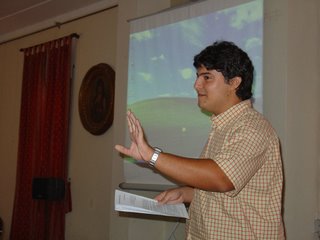
O Dr. Maia Marques.

Um dos Homens que mais fez pela História de Gaia, o Mestre Barbosa da Costa.

Um gordo que apareceu por lá... dizia-se no dia que era um fugitivo do Magalhães Lemos, recompensa a quem o devolver às autoridades.
terça-feira, agosto 01, 2006
Universidade Junior - Das Tripas Coração: Um Porto com História - Semana 4
Sabendo que "direito" é o caminho para a História, ficam aqui algumas fotografias de uma semana inesquecível, sabendo que os monitores - arredados do Tabernix, ou lá como é que se chama - já sentem saudades. Tal como juniores têm saudades do almoço de Sexta (uma espécie de "arroz à bolanhesa", que mais parecia comida de cão enlatada!!!)
Abraço para todos. E viva a Universidade Júnior, que terminou de forma espectacular.

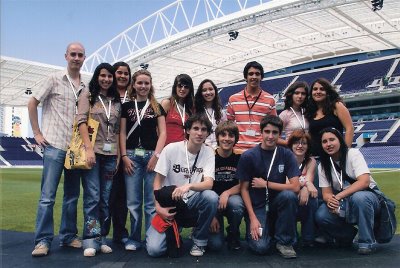














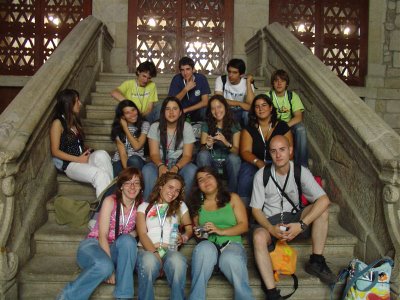






Universidade Junior - Das Tripas Coração: Um Porto com História - Semana 3





quinta-feira, julho 13, 2006
Universidade Junior - Das Tripas Coração: Um Porto com História - Semana 2


















